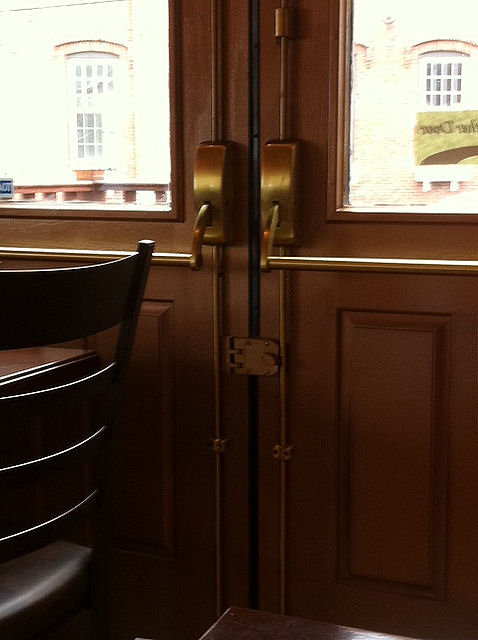 I’d love to know who did this, so I can give them a good talking-to (maybe they’ll read this and track me down like the semi-concealed closer installer).
I’d love to know who did this, so I can give them a good talking-to (maybe they’ll read this and track me down like the semi-concealed closer installer).
This photo was taken in a restaurant by one of my coworkers. The tables and chairs are blocking the door, and someone trying to exit would have to notice the deadbolt and know how to retract the latch. The deadbolt is below the allowable height for accessible hardware (36″ minimum above finished floor in Massachusetts, 34″ in most other states), and the thumbturn is not an accessible turn, which is able to be operated without tight grasping, pinching, or twisting of the wrist.
This restaurant opened recently, and the fit-up would most likely have been done under the 8th edition of the Massachusetts State Building Code (based on the 2009 IBC), which states that on Assembly occupancies with an occupant load of 50 or more, doors can not be equipped with a lock or latch unless it is panic hardware. My coworker and I talked about whether the restaurant could try to use the “THIS DOOR TO REMAIN UNLOCKED WHILE BUILDING IS OCCUPIED” get-out-of-jail-free card, but a) that’s only allowed on the main exterior door, b) there’s no signage, c) that section actually refers to key-operated locks and they must be readily-identifiable as locked, and d) additional locks are not allowed with panic hardware.
I’ve already covered most of these topics, so here are some links to previous posts:
- Mounting heights for accessible hardware.
- Accessible thumbturns.
- New occupant load requirements for panic hardware.
- Single-operation egress.
- Key-operated locks on the main entrance of certain occupancies.
I’ve emailed the restaurant and will let you know what I hear in response.
Here are the “other” choices left by poll responders:
Is there a mechanism connecting the panic hardware to the deadbolt? (no)
Report it to the fire marshal AND follow up. If not, call the tv news.
The person who signed the occupancy permit is the one that should be reported.
You need to login or register to bookmark/favorite this content.





I think we talked about this before here, but if a room has more than enough exits, can they block off the extras? I think we came up with; as long as the blocked ones are clear about not being an exit. This fails that test even if this pair is not really required. Even if they kept the deadbolt unlocked, they still have tables and chairs obstructing the egress. The sign outside says Use Other Door, but I see no sign inside.
This deadbolt does very little for security.
If someone wanted in bad enough, they simply break the glass, reach in, retract the deadbolt and then pull on the crossbar.
This is why alarm systems and door position switches were created.
All they are doing is trapping people inside an area where there is most likely open flames in the kitchen and oil in the pans.
In an emergency, the first person to the door will most likely get pushed through the glass from the backside by people behind them also trying to get out.
Lori,
You should get into why there is a need for a deadbolt (lack of security with SVR and poor installation and cross bar type devices). That there are panic devices that do provide security as well: Either single doors or pairs of doors with touchbar type rim devices with mullions and mullion stabilizers.
Dead bolts and chains are applied after the fact because of a lack of security. If properly specified and installed, life safety AND security are assured.
Proper glazing materials will prevent intrusion as well.
I just got my copy of http://www.oregon.gov/OSP/SFM/docs/Comm_Ed/Gated_Wye/2011/July_11_GatedWye.pdf
On Page 1 is list of factors in fire causing death. Egress problems were reported in 15% of fatal fires. There is no list of if the egress problems were obstructed exits, locked exits or exits that were not obvious.
Douglas Hicks
General Fire Equipment co of Eastern Oregon, Inc
Lori – just came across this post.
There is no get out of jail card – also Fails under prior knowledge
The RHR leaf can be opened at any time but the LHR leaf can only be opened after the RHR leaf. The deadbolt overlaps the RHR door and both have vertical rods. Anyone trying to get out the RIGHT (LHR) side like we drive and typically exit is stuck behind a locked door.
The only good news is the wood screws bend then will rip out of the door face if pushed hard enough
Paul
The question is, what would you do about it? I’m sure you see these situations all the time…do you tell anyone?
Depends on how dangerous it is. On this one I would go find the general manager and have a strong discussion with him. If he understood and pledged to fix it I would let it go. If he blew me off it would go up a level or two.
In my experience the managers don’t take my concerns seriously but my discussions probably aren’t as strong as yours. The fire marshals do tend to take me seriously though.